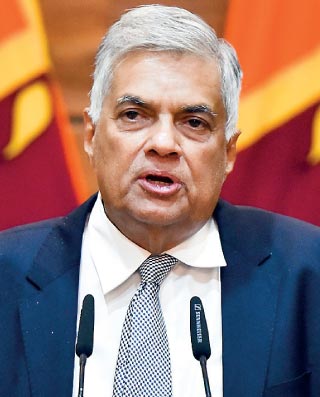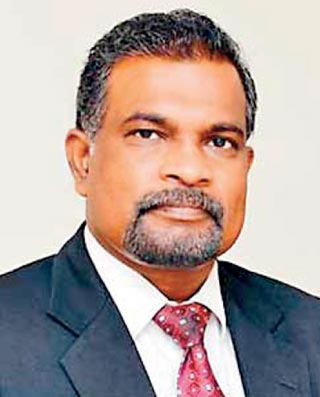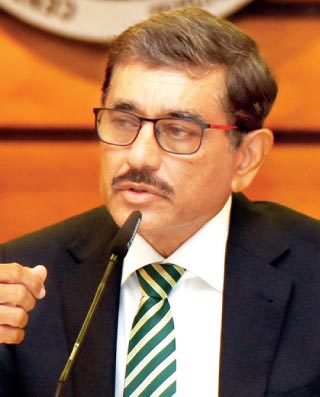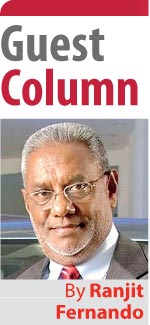Saturday Dec 20, 2025
Saturday Dec 20, 2025
Friday, 29 July 2022 00:40 - - {{hitsCtrl.values.hits}}

President Ranil Wickremesinghe

Treasury Secretary Mahinda Siriwardana

Central Bank Governor Dr. Nandalal Weerasinghe
 Introduction
Introduction
Not one of us in our wildest dreams ever thought that Sri Lanka, during our own lifetime, would be in line for humanitarian assistance from the world community. We were a proud nation. We prided, among other things, on the fact that we had never defaulted on servicing our international debt obligations. That pride is now dented. It is only right that we regain that pride. What does it take to do so?
This article is meant to focus attention on two critical questions that will determine both the success or otherwise of the debt restructuring effort and how long it may take to achieve closure. The first of them is – are we doing, all we should be doing, to hasten the successful closure of the debt restructuring effort? Secondly, do we have the political leadership that understands the daunting challenges the country presently faces, and are they willing and able to provide our people the honest, bold and selfless leadership that is required to overcome those challenges?
Are we doing all what we should be doing?
On the first question posed above, a moment’s reflection will make one realise that the restructuring of the country’s debt, though a necessary first-step to resuscitate the economy, is not a sufficient step for achieving that goal.
The IMF, which is assisting us in the debt restructuring effort, has made it abundantly clear that an essential prerequisite for the finalisation of the restructuring plan, is the submission by the Government of Sri Lanka, of a credible plan that unequivocally demonstrates that the rescheduled debt is sustainable. In other words, the country must be able to demonstrate that the debt, once rescheduled, can be serviced by the Government, in the years that follow.
It is obvious that the economy, in its current state of bankruptcy, will not be able to service the existing debt even if one optimistically assumes, that the restructuring will include one or all of the following; (a) A generous haircut by the lenders (b) A reduction of the interest rates and (c) A liberal extension of the repayment period.
Debt sustainability can only be achieved, if simultaneous to the restructuring of the debt, the country’s economy is also restructured so that the enhanced cash flows resulting from the Government, will be sufficient to service the debt.
In other words, the restructuring of debt will need to be worked out on the cash flows of a restructured economy. It also means that the restructuring of the economy has to precede or be concurrent to the finalisation of the restructuring of debt. In fact, several iterations of the forecast cash flows may have to be computed, based on different assumptions, in order to arrive at a model that appears to be realistic and achievable and at the same time holds out the prospect for servicing the debt.
Restructuring of the economy
Sri Lanka’s economy today, is the product of 73 years of mismanagement, corruption, nepotism and unaffordable welfarism practiced by successive governments that ruled the country, following independence.
All of these governments gained and sustained political power, by offering the voter a life way beyond what their own means could afford. The economy could ill afford the expenditure. The electoral process essentially took the form of a contest between political parties that tried to outdo each other, by presenting manifestos that promised the voter the most attractive package of social benefits. A process that was sarcastically referred to as an “Auction of non-existing resources” by the late Prime Minister of Singapore Lee Kuan Yu. “Affordability” was never an issue either with the electorate, or with the political leaders.
The cumulative effect of; financing the needs of a society that had got accustomed to living beyond its means, large-scale corruption at the highest levels, the funding of unviable ego-boosting projects, gross mismanagement, and the servicing of debts by further borrowings, have all resulted in the country’s debt becoming unsustainable. This compelled the country to declare, in March of this year, its inability to service the debt
All of the above have left a legacy of an economy in tatters, and structurally unsound. Deficits in the Balance of Payments and budget have become regular features. Government revenue, as a percentage of GDP, which was in the lower twenties a few years back, has shrunk, to a single digit. Military expenditure beats the budgetary allocation for education, even 13 years after the conclusion of the civil war. Emoluments to a bloated cadre in the State sector, accounted for 85% of Government revenue last year. Huge losses incurred by State Owned Enterprises, numbering more than 350, continues to be a recurring burden on the state budget.
The daunting challenge
It is a “no brainer” that the restructuring of an economy in such a deplorable state, needs a Herculean effort. It calls for ambitious revenue increasing measures, coupled with drastic cuts in Government expenditure. Such measures call for bold and radical policy changes.
The debt restructuring exercise per se, will not address the above shortcomings. They can and should be addressed only by a distinct plan to restructure the economy. Without the preparation of such a plan, simultaneous to the debt restructuring initiative, the latter will never see the light of day.
Given the current state of the economy, reaching a consensus on a blueprint for the restructure of the economy, is a far greater challenge than the formulation of the debt restructuring plan. This is because the reforms that must be undertaken to restore viability to the economy, have to be radical and far reaching. It must go beyond tinkering with the bells and whistles of the economy but focus on its fundamental weaknesses.
It is not my intention to deal with the methodology for formulating such a plan nor speculate on its contents. That will require the dedicated effort of several teams of experts. Suffice to say that it must address all issues that have materially contributed towards creating the present dismal state of the economy. Apart from including measures that will achieve a revival of the productive sectors of the economy and encouraging a rapid growth in exports, it must address controversial and politically sensitive issues such as the need to stop the huge drain of resources, to keep afloat loss-making state-owned enterprises, to slash the bloated cadre of government employees, to cut the budget for the armed forces (Rs. 375 billion in the year 2021) at least by half, etc. There is also a need to take a fresh look at our trade, industrial and agricultural policies so that we abandon the protective economic policies we have embraced and move towards integrating our economy with the global economy.
This task of restructuring the economy must be undertaken immediately. The input of all stakeholders of the economy and the expertise available with the Sri Lankan diaspora, must be mobilised to prepare the plan. The private sector and their representative chambers must play an active role in this endeavour.
An action plan and a financial plan
The economy restructuring plan must include an action plan and an assessment of funding needs, without which the reform program will remain a dead letter. The debt restructuring exercise is likely to require additional funding, for instance, to replace some of the existing debt which has already become non-performing. The issuance of instruments, such as the “Brady Bonds” that were issued in 1989, when addressing the indebtedness of the Latin American countries may be an option to consider.
In addition, the restructuring of the economy will also require the raising of additional funds to finance some essential capital expenditure. It will be difficult to raise the entirety of our funding needs via additional borrowings given the extent of existing debt. An option to consider is the sale of some selected State-owned assets, such as stakes in some loss-making State enterprises that anyhow need restructuring.
Educating the masses
The negative public sentiment on the sale of State-owned assets, it is submitted, is to a large extent the result of the public outrage towards the corruption that has been associated with many asset sales executed in the recent past. The lack of transparency, the absence of competitive bidding, the acceptance of unsolicited bids sans the normal safeguards to ensure price competitiveness, avoiding professional valuations on assets to be sold, the role of related parties in the match-making, etc. have, in the past, aroused the suspicion of the general public and more particularly the employees attached to these institutions.
The sale of a significant stake in a commercially oriented state enterprise, to an internationally reputed foreign owned corporate, selected via a transparent process, with a proven track record in the relevant field, is unlikely to be opposed by the employees and the public at large provided there is a commitment by the selected corporate to make further investments, transfer technology and create additional employment opportunities.
There is a great need to educate the masses on this subject. The strategy followed by late Minister Mangala Samaraweera in dismantling the monopoly enjoyed by the State owned Telecom Authority is a good example to follow. Quite apart from ensuring that all segments of Sri Lankan society, including those working in the Middle East, enjoy the essential convenience of connectivity, the tremendous contribution, that bold decision has made to the facilitation of trade, industry and commerce, defies estimation.
Apart from the time it takes to prepare a well-researched and comprehensive restructuring plan for the economy, a gestation period during which the plan will be implemented as well as the time required for new investments to yield optimum returns, has to be provided for. Debt servicing from net cash flows will not be possible during this period. This requirement too, underscores the need to raise some capital upfront, by for instance the sale of some State owned assets.
The time to change
The present crisis has had its own silver linings. It has made increasing numbers of the population to “think” independently. There is a greater realisation that the periodic changing of the ruling party at a General Election, is akin to changing the pillow to cure a headache. The chanting of the slogan “Unuth ekai, Munuth ekai” is something we hear more often.
A crisis almost always gives rise to an opportunity to change. One can sense a greater readiness for change, among the populous. “The Harvard Business review on Change” states that the appropriate time to introduce change is “when 75% of a company’s management is honestly convinced that business as usual is totally unacceptable”. There is a greater realisation among Sri Lankans that life in its present form, cannot go on much longer, unless fundamental changes are effected.
Summary
To summarise, the finalisation of the debt restructuring plan cannot be achieved, without a plan to restructure the country’s economy. The effort to prepare the latter must be initiated without delay. The drawing up of such a plan is bound to pose significant challenges given the present state of the economy, and the need to address many critical, socio-economic and political issues that have been tinkered with or swept under the carpet, in the past.
It will be difficult to transform the economy, despite the locational and other advantages the country enjoys, unless there is a comprehensive plan and an honest, united and visionary leadership to implement it. Regrettably, there does not appear to be much attention paid to this important aspect, at present.
The second issue referred to in para two above viz, the leadership challenge will be addressed in an article to follow.
(The writer is a former Secretary of the Ministry of Industrial Policy, Enterprise Development, Investment Promotion and Constitutional Affairs. He was the Director/Chief Executive Officer of the National Development Bank of Sri Lanka, from 1989 to 2001. He was also the Chairman of the Urban Development Authority and the Chairman of SriLankan Airlines. He holds an LL.B (Hons), Attorney-at-Law (First Class), FCIB, FCMA, Comp: CIMg.)